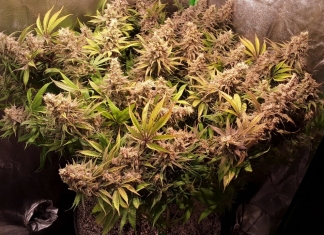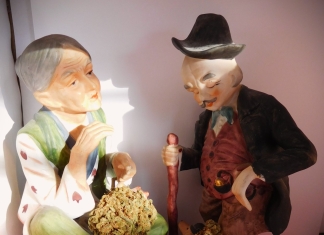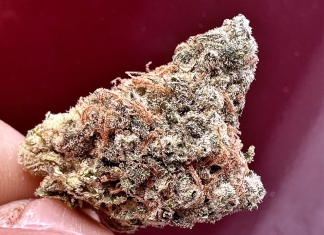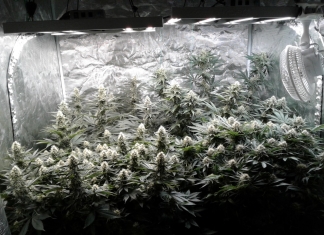The Charlevoix County Sheriff’s Office is having trouble stashing the amount of marijuana it has seized.
Charlevoix County Sheriff Chuck Vondra said the office has continually seen an increase in the quantity of pot confiscated throughout the county.
To alleviate the problem of too much weed stored in the sheriff’s facilities, Vondra made a request to the Charlevoix County commissioners this month to apply for funds under the Michigan Medical Marihuana Act of 2008 to construct or purchase an evidence storage unit.
“I don’t have the room for the amount of marijuana plants we have now,” Vondra told commissioners. “We are full.”
The funds come from the licensing money distributed by the amount of medical marijuana cardholders in the county, Vondra told commissioners.
The evidence facility would be used for storing medical marijuana and evidence obtained during medical marijuana violation complaints.
“Our plan is for an external storage because we do not have enough internal storage for the amounts of marijuana we have confiscated,” he said. “We are looking initially at a trailer where we can lock and store the evidence where people cannot get in.”
The facility would then hold the seized marijuana while the court cases move through the legal process.
“We can’t burn it or destroy the seized marijuana until the case is finished in court,” Vondra said.
Since medical marijuana became legal in Michigan, Charlevoix County continues to see more cases and more marijuana coming into the sheriff’s office faster than it can be destroyed, Vondra said.
“The deputies do a good job getting rid of the marijuana once we can, but there are rules in place that prevent us from rushing this,” he said. “Operating costs and drug cases are up because of marijuana and our biggest need right now is the evidence storage.”
In the last three years, the Charlevoix County Sheriff’s Office has received 66 marijuana complaints and seized 359 plants, 13,033.8 grams or nearly 29 pounds of marijuana, along with smaller amounts of marijuana butter, oil and candies.
“The numbers keep going up,” Vondra said. “It appears the people with the medical marijuana cards see this as a revenue stream and that is how they get into trouble with it.”
Changing opinions
Deputies also have seen an increase of marijuana in area schools. Medical marijuana policy also has changed the discussion for young people, because they may have a family member who has a medical marijuana card.
“They may have an opinion on that in their household,” Vondra said. “It definitely changes the discussion about marijuana among adolescents.”
BASES (Bay Area Substance Education Services) in Charlevoix also has seen more adolescents coming into court and treatment primarily for marijuana.
“Among the younger population there is a big spike with marijuana offenses, marijuana treatment admissions and that kind of the stuff,” said BASES director Scott Kelly.
Kelly said since medical marijuana became legal in Michigan there has been an increased use among teens.
“Younger teens and increased use for those who were already using marijuana is what we see here,” Kelly said. “The kids have the perception that every one of their peers are using, but I don’t see that to be true. However, those teens who are using are using a lot.”
Kelly is not advocating against medical marijuana. He said that he supports people seeking treatment as long as it is done legally.
“I hear a lot of people seeking medical marijuana instead of opiates for pain, and I am all for that, as long as they do it legally and follow the rules,” Kelly said. “I hear a lot of people report improved functioning from this, but I deal with addicted people and those people usually have an on switch and off switch. They have a real hard time getting into the control of their using.”
Kelly said there is data available from states that have legal marijuana use that shows there are increases in emergency room visits, increase in crime rates and assaults, increase in school dropout rates.
“Across the board there is nothing positive with this data,” Kelly said. “As the perceived risk of harm comes down, use always goes up. It is like a teeter-totter.”
Kelly said another big misconception among older people involves the potency of today’s marijuana compared to that used in decades past.
“The smokable stuff is 20 percent or higher in THC (tetrahydrocannabinol) and today they have ways to increase that up to 80 to 90 percent,” Kelly said. “What do you compare that to in the past? We never had that.”
THC, or tetrahydrocannabinol, is the chemical responsible for most of marijuana’s psychological effects. It acts much like the cannabinoid chemicals made naturally by the body, according to the National Institute on Drug Abuse (NIDA).
These higher amounts of THC are something not seen in the marijuana used the 1950s, ‘60s and ‘70s, Kelly said
“It is a grand experiment that we are kind of undergoing for those who are voluntarily participating in by using,” Kelly said.














